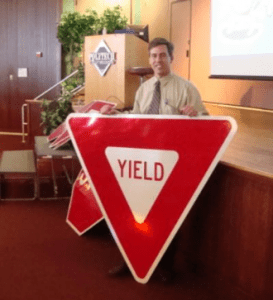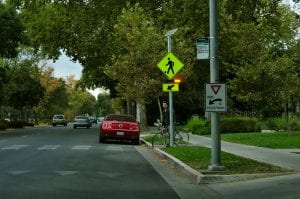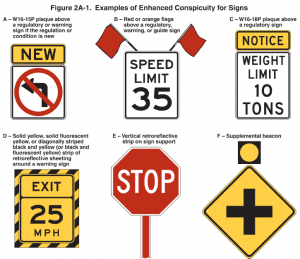Do you believe that you have one or more signs that are less effective than they could be because they are being overlooked? The Delaware Manual on Uniform Traffic Control Devices (MUTCD) contains many options for making them more conspicuous.[1]
Based upon engineering judgment, where the improvement of the conspicuity of a standard regulatory, warning, or guide sign is desired, any of the following methods may be used, as appropriate, to enhance the sign’s conspicuity (see Figure 2A-1)[2]:
- Increasing the size of a standard regulatory, warning, or guide sign. The 2009 Edition of the Federal Manual (and hence, the Delaware MUTCD)
 required some signs to be significantly larger in some instances (see example with Mark Luszcz), but where you assess the need for greater conspicuity, you can always elect to enlarge the sign size beyond the minimum required.
required some signs to be significantly larger in some instances (see example with Mark Luszcz), but where you assess the need for greater conspicuity, you can always elect to enlarge the sign size beyond the minimum required. - Doubling-up of a standard regulatory, warning, or guide sign by adding a second identical sign on the left-hand side of the roadway.
- Adding a solid yellow or fluorescent yellow rectangular “header panel” above a standard regulatory sign, with the width of the panel corresponding to the width of the standard regulatory sign. A legend of “NOTICE,” “STATE LAW,” or other appropriate text may be added in black letters within the header panel for a period of time determined by engineering judgment. Sometimes, the MUTCD limits the time these panels can remain. Regardless, panels like these should be used sparingly and (and sometimes, for limited times) so that they retain their effectiveness.
- Adding a NEW plaque (see Section 2C.62) above a new standard regulatory or warning sign, for a period of time determined by engineering judgment, to call attention to the new sign. Section 2C.62 limits the use of the NEW plaque to six months after the regulation has taken effect.
- Adding one or more red or orange flags (cloth or retroreflective sheeting) above a standard regulatory or warning sign, with the flags oriented so as to be at 45 degrees to the vertical.
- Adding a solid yellow, a solid fluorescent yellow, or a diagonally striped black and yellow (or black and fluorescent yellow) strip of retroreflective sheeting at least 3 inches wide around the perimeter of a standard warning sign. This may be accomplished by affixing the standard warning sign on a background that is 6 inches larger than the size of the standard warning sign. See Figure 2A-1.
- Adding a warning beacon (see Section 4L.03) to a standard regulatory (other than a STOP or a Speed Limit sign), warning, or guide sign.
- Adding a speed limit sign beacon (see Section 4L.04) to a standard Speed Limit sign.

- Adding a stop beacon (see Section 4L.05) to a STOP sign.
- Adding light emitting diode (LED) units within the symbol or legend of a sign or border of a standard regulatory, warning, or guide sign, as provided in Section 2A.07.
- Adding a strip of retroreflective material to the sign support in compliance with the provisions of Section 2A.21. Take special note, however, that Section 2A.21 requires that such a strip, shall be at least 2 inches in width, it shall be placed for the full length of the support from the sign to within 2 feet above the edge of the roadway, and its color shall match the background color of the sign, except that the color of the strip for the YIELD and DO NOT ENTER signs shall be red. As a side note, the chevrons in the example at right should be angled down and to the left, towards the travel lane as part of the uniformity goals of Section 1A.03 – greater consistency of traffic control devices increases the driver’s intuitive understanding of the message.
- Using other methods that are specifically allowed for certain signs as described elsewhere in this Manual.
 Since the latest edition of the MUTCD, other methods to enhance conspicuity have been developed further. For example, the Federal Highway Administration (FHWA) issued interim approval for rectangular rapid flash beacons (RRFBs) for optional use in limited circumstances. The interim approval allows for usage as a warning beacon to supplement standard pedestrian crossing warning signs and markings at either a pedestrian or school crossing where the crosswalk approach is not controlled by a yield sign, stop sign, or traffic-control signal or at a crosswalk at a roundabout. Early studies support that RRFBs in appropriate locations increase motorist yielding and help reduce vehicle and pedestrian conflicts.
Since the latest edition of the MUTCD, other methods to enhance conspicuity have been developed further. For example, the Federal Highway Administration (FHWA) issued interim approval for rectangular rapid flash beacons (RRFBs) for optional use in limited circumstances. The interim approval allows for usage as a warning beacon to supplement standard pedestrian crossing warning signs and markings at either a pedestrian or school crossing where the crosswalk approach is not controlled by a yield sign, stop sign, or traffic-control signal or at a crosswalk at a roundabout. Early studies support that RRFBs in appropriate locations increase motorist yielding and help reduce vehicle and pedestrian conflicts.
The MUTCD recognizes that some roadway agencies don’t have engineers on staff or have engineers with sufficient experience and training with respect to roadway design or traffic control devices, and, “as part of the Federal-aid Program, each State is required to have a Local Technical Assistance Program (LTAP) and to provide technical assistance to local highway agencies. Requisite technical training in the application of the principles of the MUTCD is available from the State’s Local Technical Assistance Program for needed engineering guidance and assistance.”[3]
 The Delaware T2/LTAP Center’s Municipal Engineering Circuit Rider is intended to provide technical assistance and training to local agencies and so if you have MUTCD questions or other transportation issues, contact Matt Carter at matheu@udel.edu or (302) 831-7236.
The Delaware T2/LTAP Center’s Municipal Engineering Circuit Rider is intended to provide technical assistance and training to local agencies and so if you have MUTCD questions or other transportation issues, contact Matt Carter at matheu@udel.edu or (302) 831-7236.
[1] Conspicuous – standing out so as to be clearly visible; evident, apparent, overt, visible, blatant, noticeable, etc.
[2] Delaware MUTCD, Section 2A.15
[3] Delaware MUTCD, Section 1A.09, ¶06


You must be logged in to post a comment.